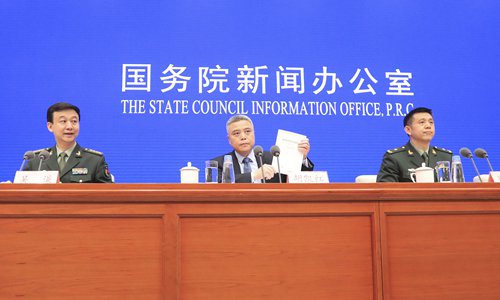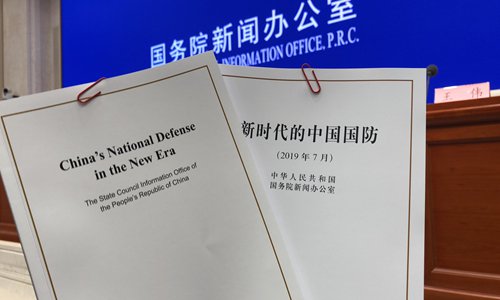HOME >> CHINA
China will never seek hegemony: defense white paper
By Liu Xuanzun and Leng Shumei Source:Global Times Published: 2019/7/24 12:07:13
White paper stresses China’s peaceful intentions

Hu Kaihong (center), a spokesperson of the State Council Information Office, presents China's 10th national defense white paper at a press conference on Wednesday. Photo: IC

Photo: Liu Xuanzun
China released its 10th national defense white paper on Wednesday, which established a defensive national defense system of the People's Liberation Army (PLA) in the new era to demonstrate the Chinese military's peaceful development strategy and slammed the US' unilateralism that has undermined global stability.The white paper attracted particular attention as it was released amid escalating tensions between China and the US since the outbreak of the US-initiated trade war.
For the first time, the 27,000-word Chinese language white paper, titled China's National Defense in the New Era, cited "never seeking hegemony, expansion or spheres of influence" as a distinct feature of China's national defense.
Although China has expressed similar contexts in the past, to clarify this feature in the white paper is of great significance as it shows the world that the Chinese military's development is peaceful, Zhou Bo, director of the Security Cooperation Center of the Office for International Military Cooperation at China's Ministry of National Defense, told the Global Times.
Zhou noted that since the Chinese military has been participating in more military operations other than war in recent years, it is necessary for the PLA to reiterate its fundamental principle, especially given that some countries have showed concerns over the country's military development.
The white paper also for the first time defined that the PLA's missions and tasks are to provide strategic support to consolidate the leadership of the Communist Party of China (CPC) and the socialist system, safeguard national sovereignty, unity and territorial integrity, protect China's overseas interests, and promote world peace and development.
It is China's 10th defense white paper since 1998 and also the first comprehensive defense white paper since the 18th National Congress of the CPC. It was released to clarify China's defensive national defense strategy, to better introduce the development of the PLA to the international society, and to enhance China's and other countries' mutual trust and cooperation, Senior Colonel Wu Qian, spokesperson of Ministry of National Defense, said at the press conference of the white paper.
The white paper also confirmed that Type 15 tanks, Type 052D destroyers, J-20 fighters and DF-26 intermediate and long-range ballistic missiles have been commissioned into the Chinese military.
This is also the first defense white paper since China launched military reform in November 2015.
It detailed the reformed leadership and command architecture of the military, and also introduced all military branches, including their components and missions.
It is an indication of the PLA's increasing transparency, openness and confidence, said Zhang Junshe, a senior research fellow at the PLA Naval Military Studies Research Institute.
Confident despite US pressure
International strategic competition is rising. The US has adopted unilateral policies, which provoke and intensify competition among major countries, significantly increased its defense expenditure, pushed for additional capacity in nuclear, outer space, cyber and missile defense, and undermined global strategic stability, the white paper read.
The US is undoubtedly undermining global stability, according to Zhou. For example, the US has increased its so-called freedom of navigation operations in the South China Sea since Donald Trump took office, which has raised risks in crisis management and control, he said.
Trump also withdrew the US from the Iran nuclear agreement and the Intermediate-Range Nuclear Forces Treaty with Russia, which increased uncertainty for the new strategic arms control treaty and damaged global stability, Zhou noted.
The release of the white paper at this time indicated the PLA's confidence despite pressure from the US side, Zhang said.
Li Daguang, a professor at the National Defense University of the PLA, echoed with Zhang, noting that some certain forces in the US had long been hyping the "China threat" theory in order to contain China's development.
However, the fact is that China always upholds a defensive national defense strategy and has been playing a more and more important role in safeguarding global stability, Li said.
The development of the Chinese military in recent years is consistent with China's fast economic growth, which is very reasonable, as military strength is needed to protect the fruits of development, Li stressed.
Security risks
The international security situation China is facing is unstable and uncertain, the white paper said, noting that regional conflicts and wars continue and international strategic competition is on the rise.
The white paper named "Taiwan independence" separatists forces and their actions as the greatest immediate threat to peace and stability in the Taiwan Straits and the biggest barrier to the peaceful reunification of the country.
Taiwan secessionists have only one destiny--nowhere. The PLA will try its best to realize the reunification and have the fortitude to risk a war, Wu said.
The white paper also said that external separatist forces for "Tibet independence" and the creation of "East Turkistan" launch frequent actions, posing threats to China's national security and social stability.
Since 2014, the PLA has assisted the local government of Xinjiang Uyghur Autonomous Region in wiping out 1,588 violent terrorist gangs and capturing 12,995 terrorists, according to the white paper.
China's homeland security still faces threats. Land territorial disputes are yet to be completely resolved. Disputes still exist over the territorial sovereignty of some islands and reefs, as well as maritime demarcation, the white paper noted.
Countries from outside the region conduct frequent close-in reconnaissance on China by air and sea, and illegally enter China's territorial waters and airspace near China's islands and reefs, undermining China's national security, it read.
As part of its national defense strategy, China needs to develop its military to fulfill its mission, including safeguarding territorial integrity and maritime rights, Zhang said.
Moderate spending
The white paper also explained why China's military expenditure is reasonable and moderate. It compares China's military expenditure with other countries in detail.
According to the white paper, from 2012 to 2017, China's average defense spending accounted for 1.3 percent of the national GDP. Figures of some other countries are: the US, 3.5 percent; Russia, 4.4 percent; the UK, 2.0 percent; and France, 2.3 percent.
As the world's second largest economy, China's defense spending/GDP ratio is low and reasonable compared to other countries, Chinese analysts said.
China's military spending is the world's second largest, which is determined by China's national defense requirements, the size of its economy and national defense policy, the white paper said, noting that China's total spending on national defense was less than a quarter of the US' in 2017.
In the past 30 years, the military spending/GDP ratio always remained within 2 percent, the white paper said.
In 1979, China's military spending accounted for 5.43 percent of the country's GDP, which dropped to 1.26 percent in 2017, according to figures in the white paper.
China's military expenditure is not high at all, even low compared to some major countries. There isabsolutely no reason to hype the "China threat" theory, Zhang said.
Li noted that China's growing responsibility in safeguarding international public security accounted for part of the expenditures.
The Chinese military's overseas operations do not contradict its peaceful role, Wu said, noting China is also responding to the international society's expectation and providing international public security goods.
By December 2018, the PLA had attended 24 UN peacekeeping operations and dispatched more than 39,000 peacekeeping military personnel, including 13 who sacrificed their lives in the frontline. China has also trained more than 1,500 peacekeeping personnel from dozens of countries, according to the white paper.
China started to dispatch navy ships to the Gulf of Aden and Somali waters to provide escort services since 2008. In the past decade, the Chinese navy has sent more than 100 warships and 26,000 military personnel to escort about 6,600 ships, and secured and helped 70 ships from danger, it said.

Newspaper headline: Defense strategy defined
Posted in: MILITARY